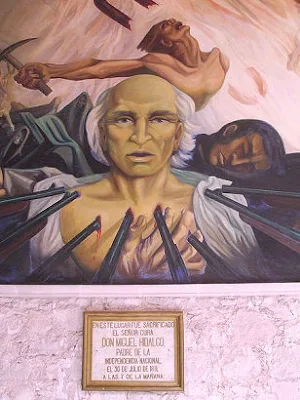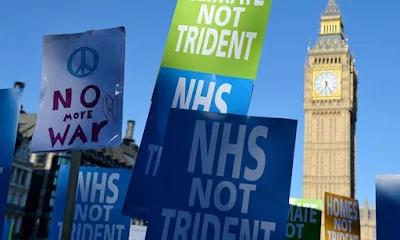A Roman Catholic, Hidalgo’s father made sure his sons were well-educated. Miguel Hidalgo studied with the Jesuits and later in Mexico City where he learned Latin but also various indigenous languages. Hidalgo was ordained as a priest in 1799. He taught and eventually became Dean of the Colegio de San Nicholas in Michoacan. His espousal of Enlightened ideas imported from Europe eventually led to his removal from this college and transfer to the Dolores parish. Hidalgo’s ideas about the priesthood were certainly revolutionary for the times; he did not support the ideal of clerical celibacy openly living with a mistress and fathered several children in his life. He was forced to appear before the Inquisition for his beliefs but was not found guilty. While in Dolores, Hidalgo often disregarded Spain’s class system and frequently socialized with Creoles, Mestizos, and Indigenous people.
Despite his traditional education for the priesthood , Hidalgo rejected or questioned many of Catholicism's most fundamental tenets, including the Virgin birth, clerical celibacy and the existence of hell. Until 1809 he pursued his
priestly functions and exerted himself to introduce various forms of
industry among his parishioners at Dolores. After Napoleon's invasion of
Spain in 1808, the colonies, unwilling to accept a French ruler, loudly
proclaimed Ferdinand VII as king. The societies they formed professed
loyalty to Spain, but authorities suspected they were designed to
prepare for independence.
The local parish priest was one of the most influential in the community and Father hidalgo often served as the host for social gatherings in his home where he would speak to a elect group of friends and potential conspirators about whether it was the duty of the people to obe y an unjust tyrant or overthrow him. The unjust tyrant he was referring to was Charles IV, the present king of Spain.
Not only did Father Hidalgo observe injustice and cruelty in his daily work with the poor, he also strongly opposed many of the king's policies. For example, rather than encouraging the growth of the colony as his father, had done, Charles1V exploited the country's wealth with schemes like his plan to use the charitable funds of the church to help pay for his European wars.
Hidalgo and several of his friends engaged in preparations which the authorities considered treasonable. Warned by the arrest of a friend, Hidalgo gathered several hundred of his parishioners, and on September 16, 1810, Father Hidalgo rang the church bell to announce revolution against the Spanish. Reaching out to the crowd from the pulpit in what has become known as the "Gritto de Dolores", (the Cry of Dolores) calling upon the people to revolt against the European-born Spaniards who had overthrown the Spanish Viceroy and announced his intention to declare independence from Spain and exhorted the crowd to join him. The people responded by shouting 'death to the Gauchupines" A name given to the Peninsulares.
Hidalgo and several of his friends engaged in preparations which the authorities considered treasonable. Warned by the arrest of a friend, Hidalgo gathered several hundred of his parishioners, and on September 16, 1810, Father Hidalgo rang the church bell to announce revolution against the Spanish. Reaching out to the crowd from the pulpit in what has become known as the "Gritto de Dolores", (the Cry of Dolores) calling upon the people to revolt against the European-born Spaniards who had overthrown the Spanish Viceroy and announced his intention to declare independence from Spain and exhorted the crowd to join him. The people responded by shouting 'death to the Gauchupines" A name given to the Peninsulares.
Many flocked to join him, and he soon had an army of 600 men, the uprising pitted the poor indigeneous indians and and mixed mestizo groups against the privileged classes and pushed them into a violent and bloody battle for freedom from Spain.
Hilgado's declaration launched a decade long struggle that ended 300 years of colonial rule, established a independent Mexico anf gelped cultivaye a unique Mexican identity. The anniversary of Hidalgo's call is
celebrated as the country's birthday.
Joined by Ignacio Allende as their military commander, and with Father Hidalgo at their head, the army of the people marched for San Miguel, gathering strength as it marched. The revolutionaries surprising the authorities with their intensity took San Miguel with little trouble and the local militia men joined them. The rebellion snowballed with astonishing rapidity. Looting and
pillaging Spanish residences and public buildings, armed with machetes,
slings, and farming implements, the crowd had become an impassioned mob
of thousands.
Around noon on September 28, the ragtag army reached the provincial capital of Guanajuato, where they had their first sustained encounter with the Spanish military. Overrunning the town by sheer force of numbers, the crowd slaughtered some 500 Spaniards, burning, pillaging, looting the granary, and wreaking widespread havoc. Over the next month, the army continued on its rampage, taking the provincial capitals of Zacatecas, San Luis Potosí, and Valladolid before heading toward Mexico City, the heart of Spanish power in the Americas. On October 30, 1810, at Monte de las Cruces on the outskirts of Mexico City, Hidalgo’s 80,000 to 100,000-strong army defeated a much smaller but formidable Spanish force sent to stop them. At this point, Hidalgo made what many consider his most momentous and enigmatic decision.
Instead of following the advice of his lieutenants and sentiments of the crowd and descending into the colony’s capital city, he opted to retreat. Scholars continue to debate his reasons, though most consider that he found intolerable the prospect of the mass slaughter that would surely follow.
From this point the movement rapidly lost momentum, as his makeshift army divided and desertions mounted. Hidalgo lost heart and retreated. His forces were decisively defeated at Aculo on November 7, 1810, and at the bridge of Calderón on Río Santiago on January 17, 1811.Father Hidalgo and Allende were forced to flee north, but once in Texas they were betrayed by local insurrrection leader Ignacio Elizonda and turned over to the Spanish authorities. The Spanish sent them to Chihuahua to stand trial where they were found guilty and sentenced to death. Allende was executed by firing squad on June 26, 1811, shot in the back as a sign of dishonor, but Father Hidalgo, as a priest, had to undergo a civil trial and answer to the inquisition as well. He was eventually stripped of his priesthood and executed as a rebel on July 30th. The heads of both Hidalgo and Allende were preserved and hung on the walls of the granary at Guanahuato as a warning to those foolish or brave enough to follow in their footsteps.
Even though the revolution had failed, it opened the people eyes to the possibility of freedom and the priests martyrdom allowed others to pick up his mantle. The struggle for independence continued for several years until a group of liberals forced the king to make changes that frightened the conservatives in Mexico City. The conservatives finally joined forces with the followers of Father Hidalgo to defeat the Spanish, and on August 24, 1821, a treaty was signed granting Mexico independence from Spain. Mexicans celebrate national independence on September 15–16, in commemoration of Hidalgo’s Grito de Dolores, even though actual independence did not come until 11 years after the revered priest’s fateful cry. Every year at midnight on September 15 Mexicans led by their President, shout the Grito, honouring the crucial and impulsive action that was the catalyst for the country;s bloody struggle for independence. Father Miguel Hidalgo y Costilla is today remembered and revered as the father of his country and is seen as the great hero of Mexico's' long struggle for Independence and champion of the downtrodden and oppressed. His insurgency lit the fire for revolution, he remains an icon of liberation. His remains lie in Mexico City in a monument known as 'the angel of Independence along with other revolutionary heroes and though he never lived to see an independent Mexico ,he is regarded as the 'father ; of the nation ad is t focus of the annual celebration on 15/16,
Around noon on September 28, the ragtag army reached the provincial capital of Guanajuato, where they had their first sustained encounter with the Spanish military. Overrunning the town by sheer force of numbers, the crowd slaughtered some 500 Spaniards, burning, pillaging, looting the granary, and wreaking widespread havoc. Over the next month, the army continued on its rampage, taking the provincial capitals of Zacatecas, San Luis Potosí, and Valladolid before heading toward Mexico City, the heart of Spanish power in the Americas. On October 30, 1810, at Monte de las Cruces on the outskirts of Mexico City, Hidalgo’s 80,000 to 100,000-strong army defeated a much smaller but formidable Spanish force sent to stop them. At this point, Hidalgo made what many consider his most momentous and enigmatic decision.
Instead of following the advice of his lieutenants and sentiments of the crowd and descending into the colony’s capital city, he opted to retreat. Scholars continue to debate his reasons, though most consider that he found intolerable the prospect of the mass slaughter that would surely follow.
From this point the movement rapidly lost momentum, as his makeshift army divided and desertions mounted. Hidalgo lost heart and retreated. His forces were decisively defeated at Aculo on November 7, 1810, and at the bridge of Calderón on Río Santiago on January 17, 1811.Father Hidalgo and Allende were forced to flee north, but once in Texas they were betrayed by local insurrrection leader Ignacio Elizonda and turned over to the Spanish authorities. The Spanish sent them to Chihuahua to stand trial where they were found guilty and sentenced to death. Allende was executed by firing squad on June 26, 1811, shot in the back as a sign of dishonor, but Father Hidalgo, as a priest, had to undergo a civil trial and answer to the inquisition as well. He was eventually stripped of his priesthood and executed as a rebel on July 30th. The heads of both Hidalgo and Allende were preserved and hung on the walls of the granary at Guanahuato as a warning to those foolish or brave enough to follow in their footsteps.
Even though the revolution had failed, it opened the people eyes to the possibility of freedom and the priests martyrdom allowed others to pick up his mantle. The struggle for independence continued for several years until a group of liberals forced the king to make changes that frightened the conservatives in Mexico City. The conservatives finally joined forces with the followers of Father Hidalgo to defeat the Spanish, and on August 24, 1821, a treaty was signed granting Mexico independence from Spain. Mexicans celebrate national independence on September 15–16, in commemoration of Hidalgo’s Grito de Dolores, even though actual independence did not come until 11 years after the revered priest’s fateful cry. Every year at midnight on September 15 Mexicans led by their President, shout the Grito, honouring the crucial and impulsive action that was the catalyst for the country;s bloody struggle for independence. Father Miguel Hidalgo y Costilla is today remembered and revered as the father of his country and is seen as the great hero of Mexico's' long struggle for Independence and champion of the downtrodden and oppressed. His insurgency lit the fire for revolution, he remains an icon of liberation. His remains lie in Mexico City in a monument known as 'the angel of Independence along with other revolutionary heroes and though he never lived to see an independent Mexico ,he is regarded as the 'father ; of the nation ad is t focus of the annual celebration on 15/16,





















